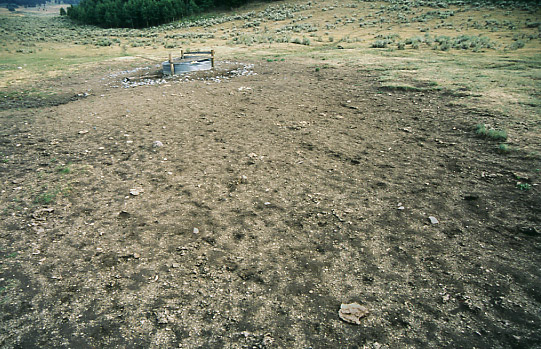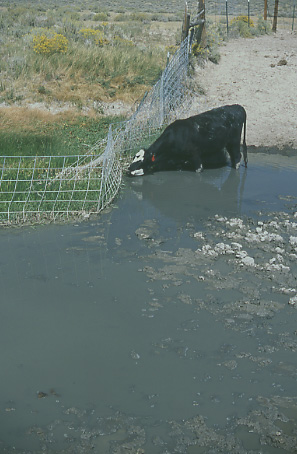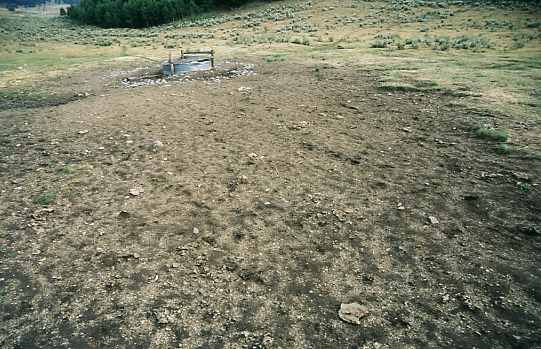
Ranching, environmentally destructive wherever it occurs, is an ongoing tragedy being played out on America’s public lands. Because many of these lands are ill-suited to ranching, damage to the environment is often accompanied by direct or indirect harm to local wildlife.
The American people, too, have been victimized by ranching on public lands—betrayed by government officials who have shirked their legal responsibility to insure that it is environmentally sustainable. Like WDFW has done
What exactly is public-lands ranching? It is quite simply ranching that occurs on public rather than on private lands. In the United States, ranched public lands fall under a variety of jurisdictions, including city, county, state, and federal. But the majority of such lands are managed by ten agencies of the federal government, the most important of which are the United States Forest Service (USFS) and the Bureau of Land Management (BLM).
Most ranched federal lands are located in the 11 western states (Arizona, California, Colorado, Idaho, Montana, Nevada, New Mexico, Oregon, Utah, Washington, and Wyoming). Currently, the USFS manages approximately 97 million acres for ranching, while the BLM manages 163 million acres for that purpose. The total number of active grazing permits during 2015 on lands managed by these agencies was approximately 26,000. Due to some ranchers holding multiple permits, sometimes under different ranch names, determining the number of individual ranch owners with federal permits is less certain, but has been estimated at around 22,000.
Historical background
Today’s federal public lands typically entered the public domain because 19th-century ranchers did not regard them as sufficiently valuable to warrant purchase. Such lands may have lacked a water source, possessed poor soil, or been subject to a short growing season due to high elevation. Nevertheless, ranchers who had purchased more productive adjacent lands would graze their livestock on these public lands as well. In fact, several ranchers might simultaneously graze their livestock on a common parcel of public land, leading to the environmental destruction referred to in the title of Garrett Hardin’s article “The Tragedy of the Commons” (1968).
Throughout the late 19th century, relentless overgrazing of cattle and domestic sheep extirpated native grasses, leading to soil erosion and the downcutting of streams (the lowering of streambeds by the abrasive action of running water). Consequently, water tables dropped, and many perennial streams flowed only after heavy rains. These degradations to streams, as well as those to uplands, had devastating consequences for much of the wildlife that lived there.
Yet, until the establishment of the USFS in 1905, few federal public lands, notably excepting national parks, were subject to governmental oversight. In 1916 Forest Service lands on which grazing occurred became subject to the Organic Act, which required that all federal lands be managed sustainably for “multiple uses.” Today, these uses, broadly speaking, include lumbering, mining and drilling, livestock grazing, and recreation.
Grazing on federal lands subsequently continued under a system of “allotments,” in which ranchers paid a minuscule monthly fee to graze each cow and her calf. (The fee was 5 cents in 1906, the equivalent of $1.28 in 2016. While the current fee is ahead of inflation over that period, American taxpayers, not rancher permittees, pick up most of the government management costs. A 2005 U.S. Government Accountability Office [GAO] report found that to recover management expenditures in 2004, the BLM and Forest Service would have had to charge monthly fees of $7.64 and $12.26, respectively.) The location, intensity, and duration of the grazing were also regulated by a management plan devised by the government.
The Taylor Grazing Act of 1934 brought governmental regulation of ranching to many federal lands not incorporated into national forests. These lands are today managed by the BLM. The Federal Land Policy and Management Act (FLPMA) of 1976 required both BLM and USFS lands to be managed sustainably under the multiple-use principle.
In theory, governmental management should have restored the environmental health of the lands, allowing wildlife populations to flourish again. In practice, however, the populations of many species, other than game animals (such as deer and elk) and “generalists” (animals that can thrive in a variety of habitats), continued to plummet.
With the enactment of the Endangered Species Preservation Act of 1966, the Endangered Species Conservation Act of 1969, and finally the Endangered Species Act (ESA) of 1973, the U.S. government began to conduct serious studies of trends in the populations of nongame wildlife, which revealed that many species were being harmed by ranching on public lands. The ESA also created an administrative framework through which citizens could petition to have a species (flora as well as fauna) listed as threatened or endangered.

Starving cow attempting to reach grass on the ungrazed side of a fence, Granite Mountain Open Allotment–Courtesy Mike Hudak
Overgrazing is not the only way in which ranching harms wildlife. Many practices related to or in support of ranching have also decimated wildlife populations on grazed federal lands. Among these, none has been more obvious than the relentless and widespread hunting of the competitors and predators of livestock. Wolves, grizzly bears, and mountain lions were exterminated long ago in many areas of the American west through the combined efforts of ranchers, farmers, and special government agents charged with “animal damage control” (such agents are now organized in a section of the U.S. Department of Agriculture known as “Wildlife Services”). Prairie dogs, a competitor of livestock, were reduced in population to less than 1 percent of their estimated pre-19th century numbers. Because prairie dogs share dependencies with approximately 200 other wildlife species of the prairie ecosystem, their decimation led to drastic declines in the populations of these other animals. Among them, none has been more adversely affected than the black-footed ferret. Once numbering in the tens of millions, by 1986 the species had dwindled to only 18 free-living individuals.
Other aspects of ranching also contribute to the harms suffered by wildlife. Fences thwart the migration of native ungulates (hooved animals), which can lead to death during times of environmental stress, such as droughts and blizzards. Fences also impale birds. Landscapes worn out by decades of overgrazing are often reseeded with nonnative grasses that differ significantly in stature and taste from the native grasses they replace, thus providing no benefit to niche-dependent wildlife. And, prior to reseeding, weeds will have been killed with herbicides, which often poison stream invertebrates and accumulate in the bodies of the fish that consume them.
Ranching requires roads, the construction of which kills plants and animals directly. The existence of roads opens up wilderness areas to human activities, such as hunting, wood cutting, and driving off-road vehicles, all of which harm—or have the potential to harm—wildlife. Roads also provide pathways for the spread of weeds, further contributing to the degradation of overgrazed landscapes.
How extensive is the carnage that ranching inflicts on wildlife? One reasonable measure is the number of affected species that are either (1) federally listed as threatened or endangered, (2) candidates for federal listing, or (3) the subject of petitions for federal listing. By that criterion, ranching’s victims number 151 species in all: 26 species of mammals, 25 species of birds, 66 species of fish, 14 species of reptiles and amphibians, 15 species of mollusks, and 5 species of insects.
In addition, at least 167 other species are harmed by ranching through the degradation of their habitats, though they are not so severely imperiled that they currently warrant federal protection.
Source: Public Lands Ranching: The Scourge of Wildlife – Advocacy for Animals
